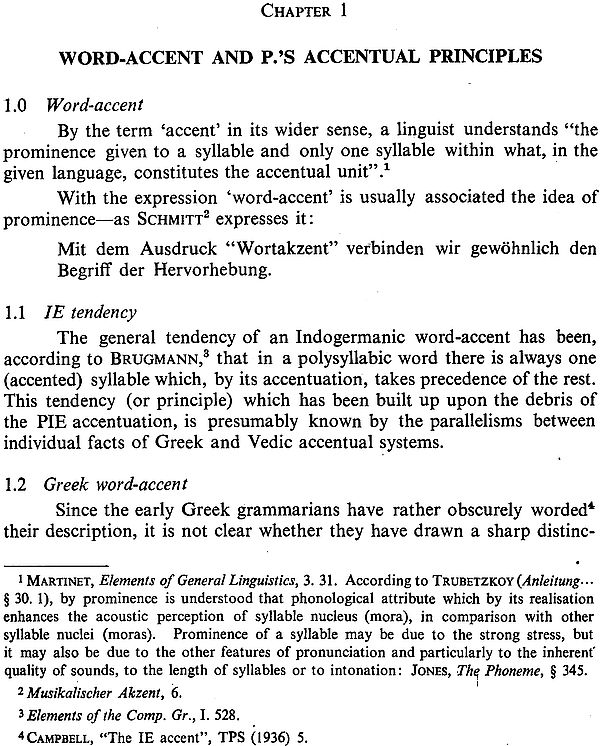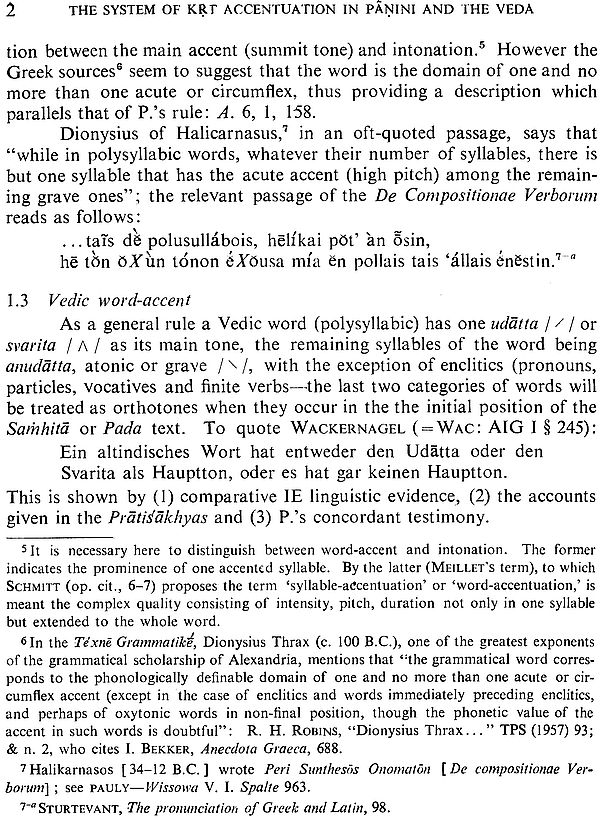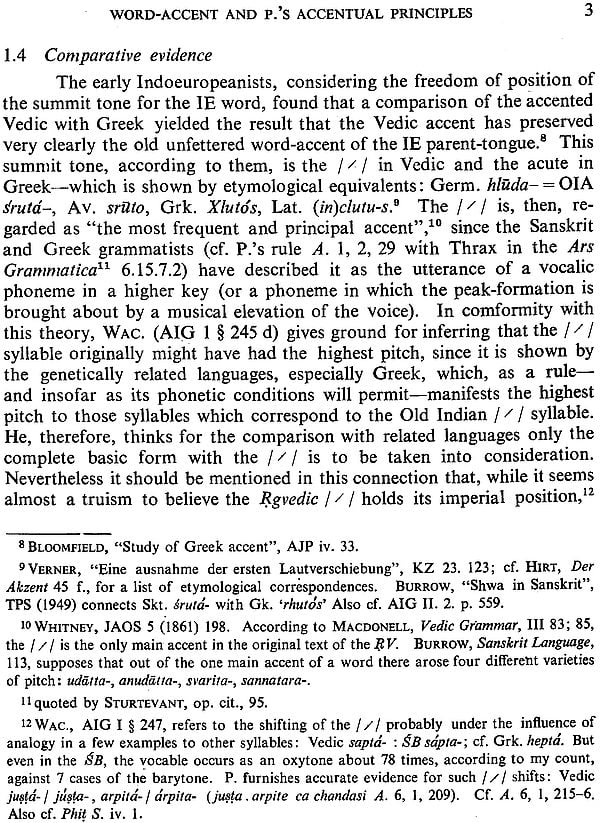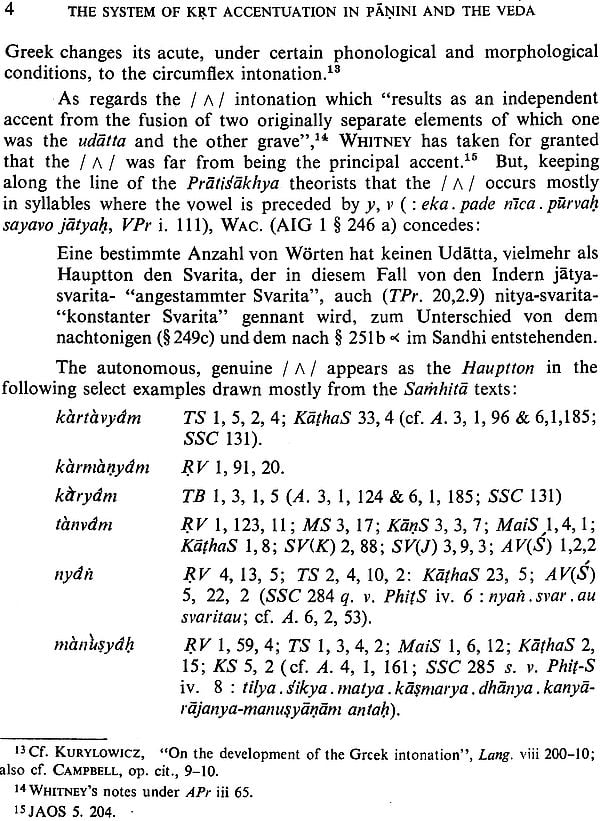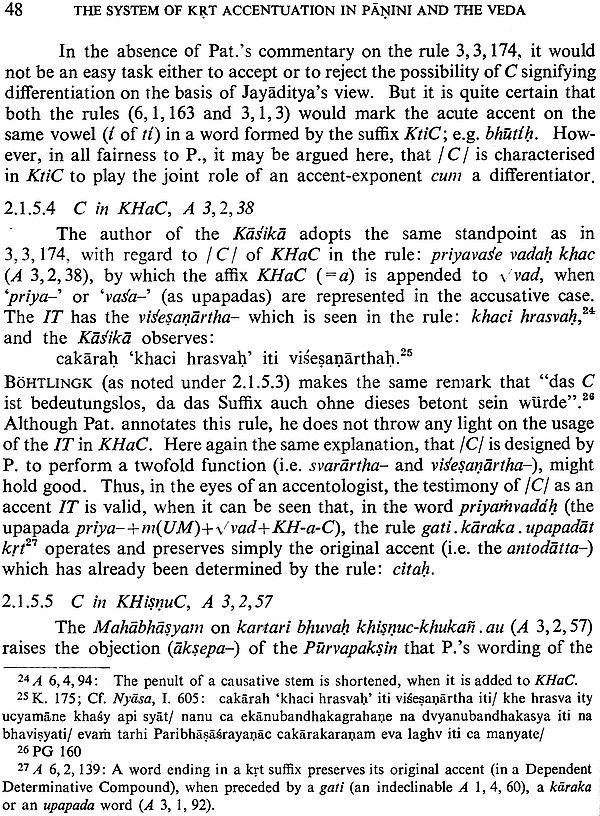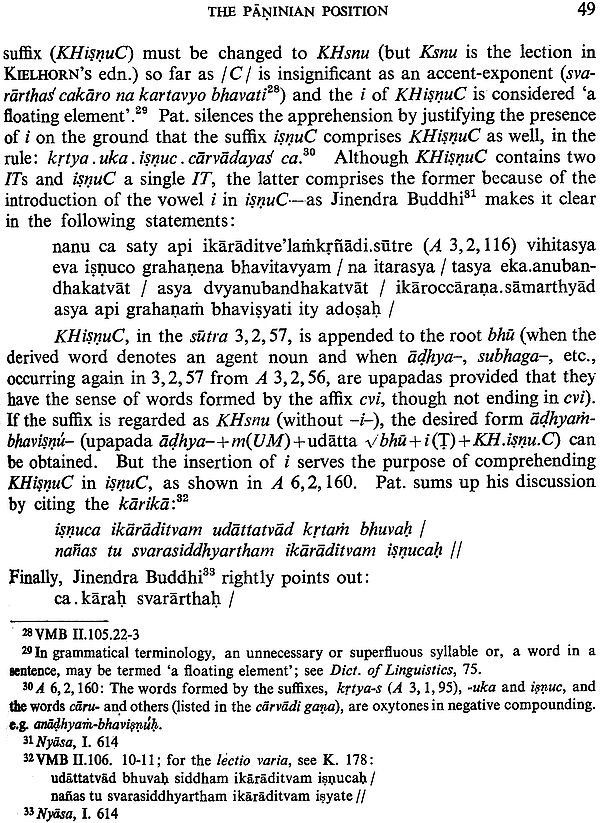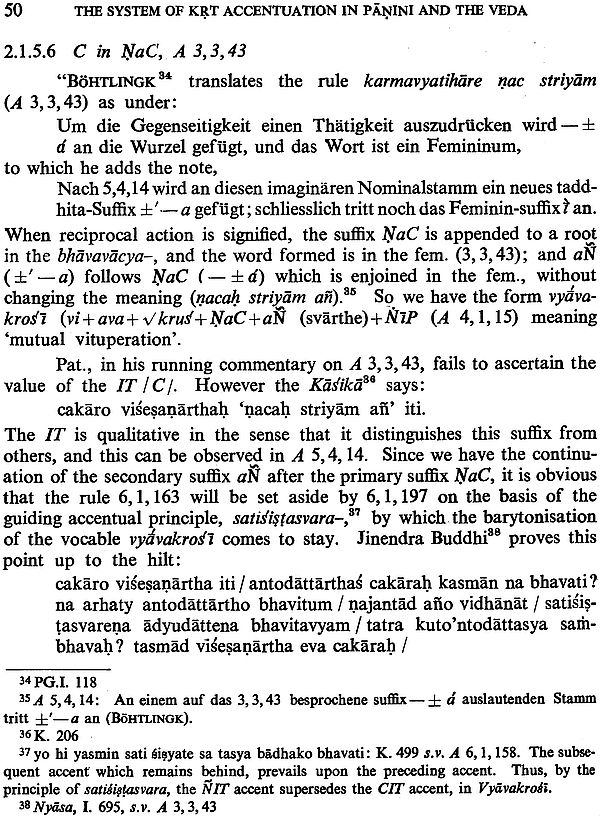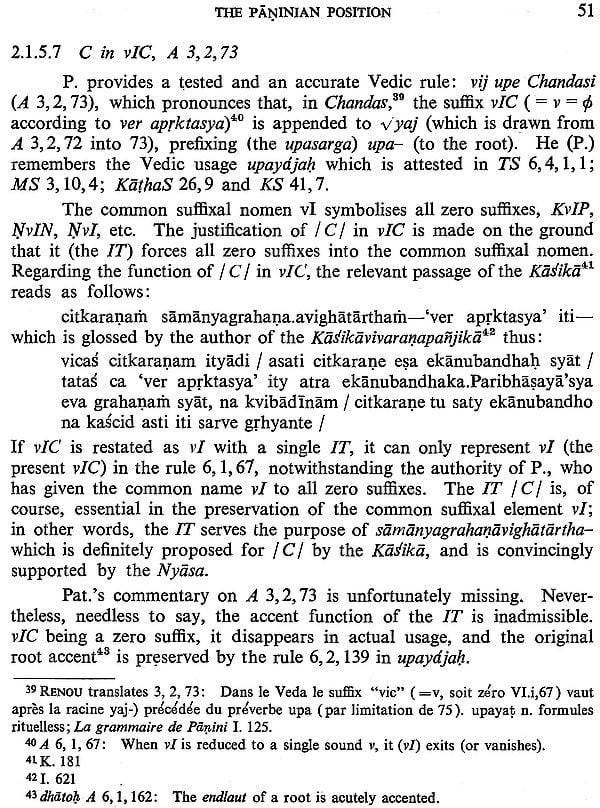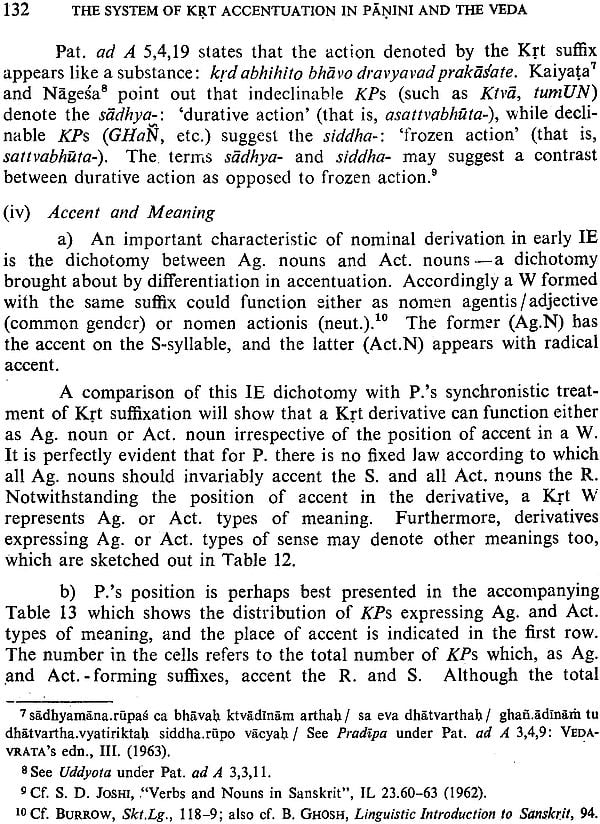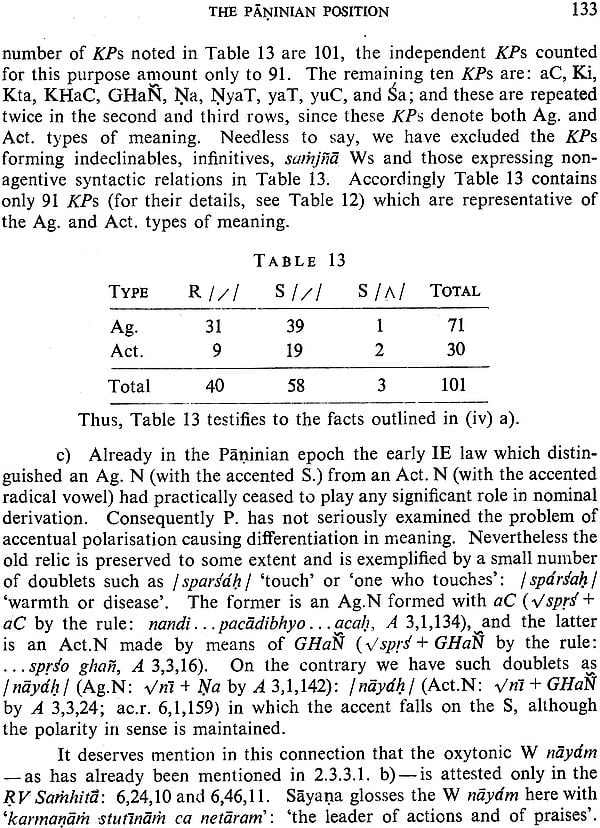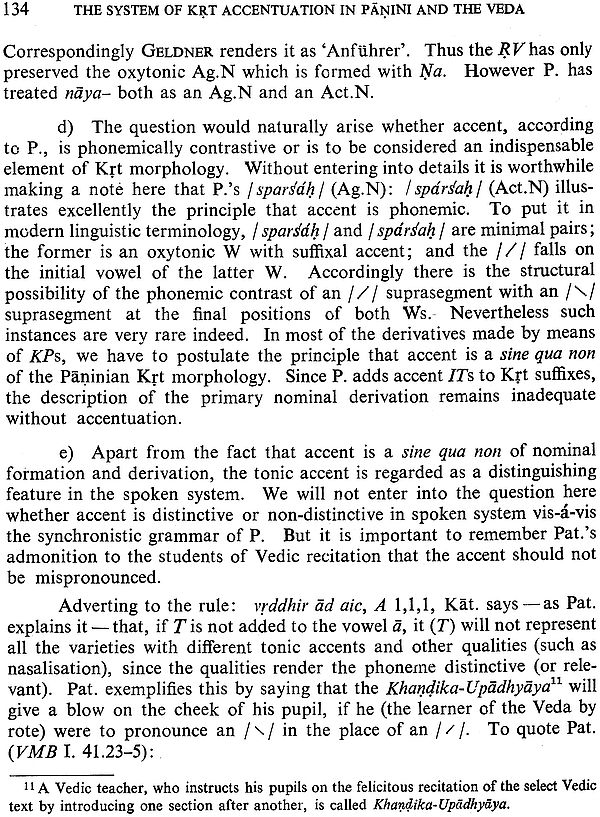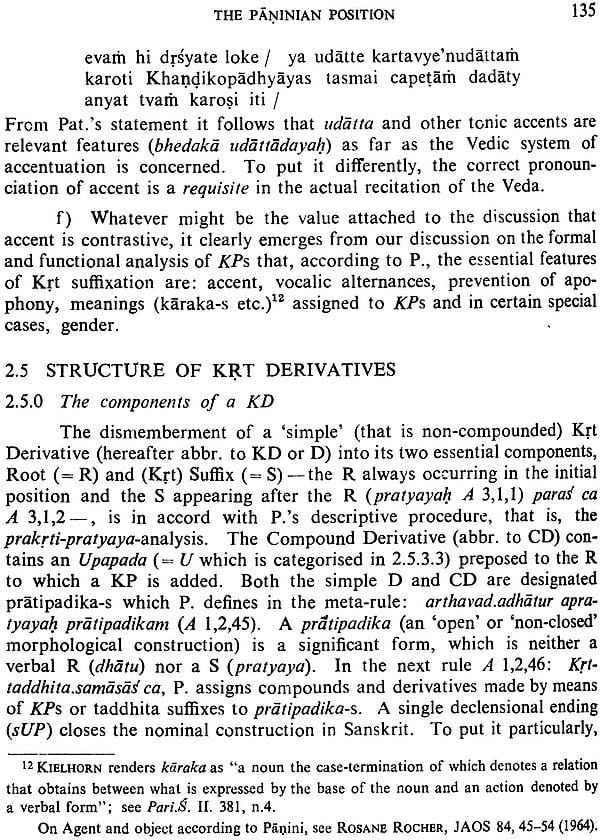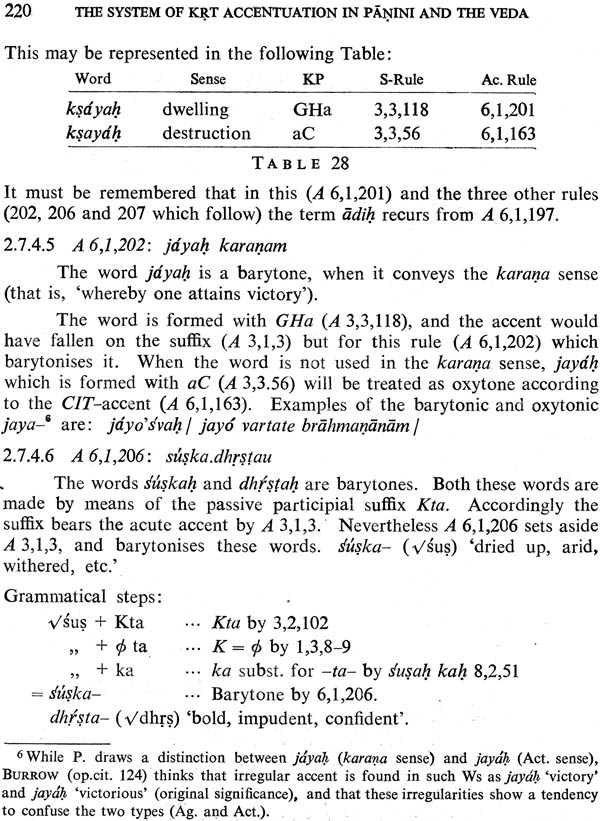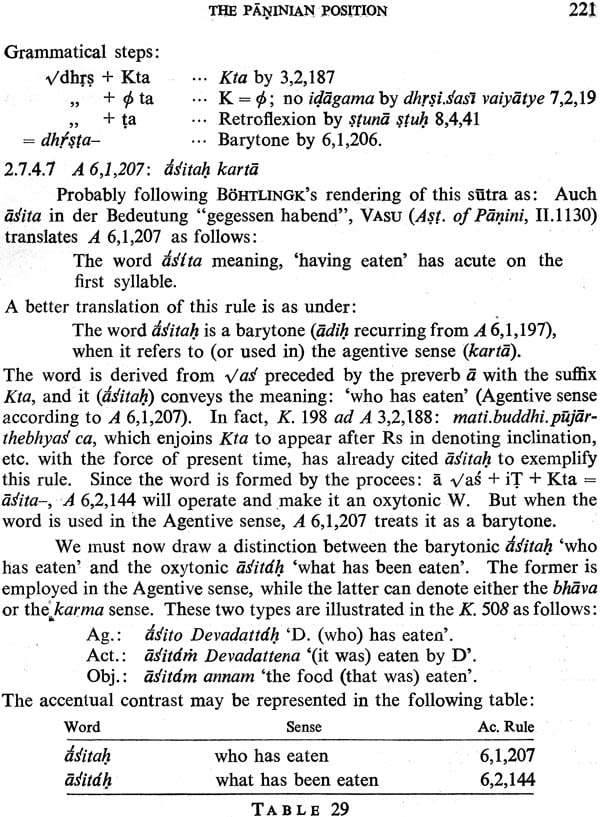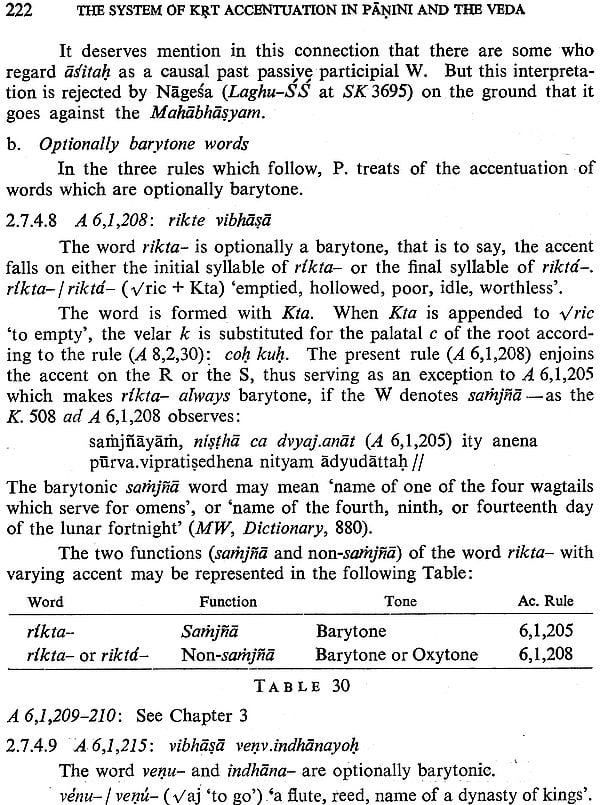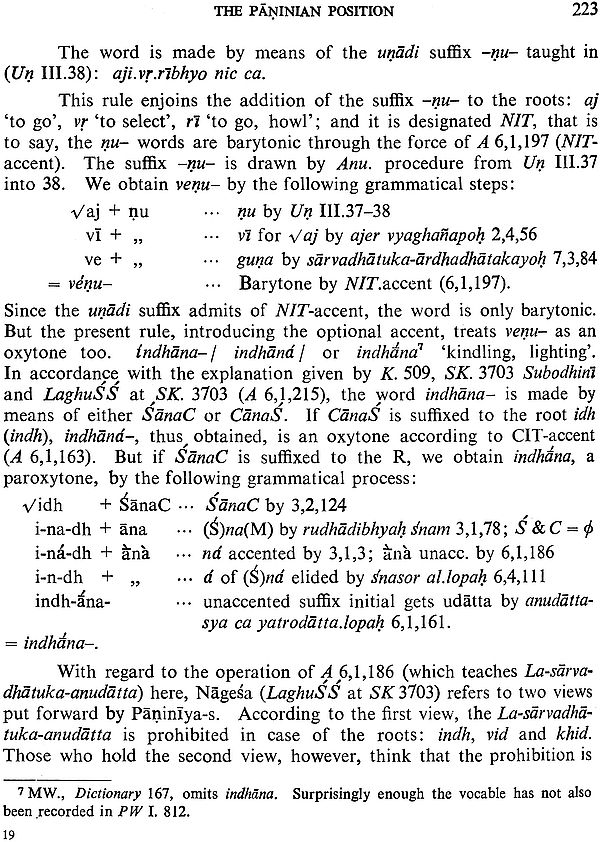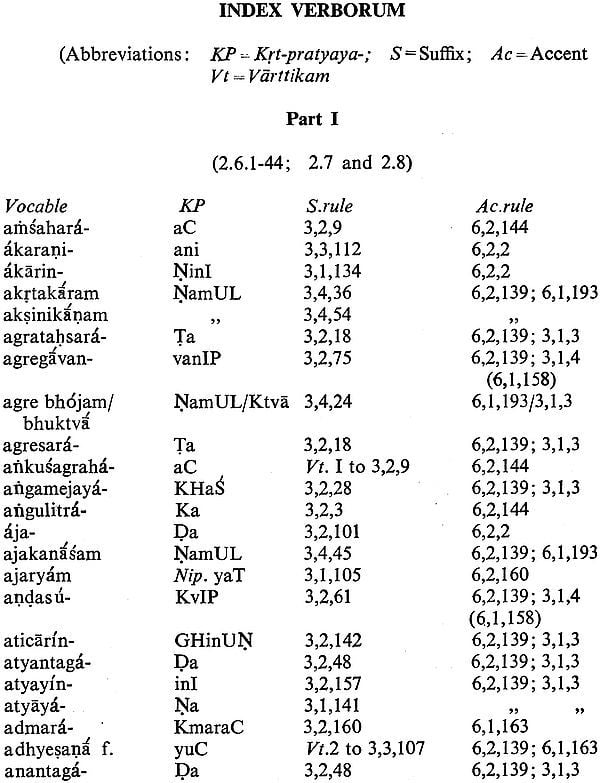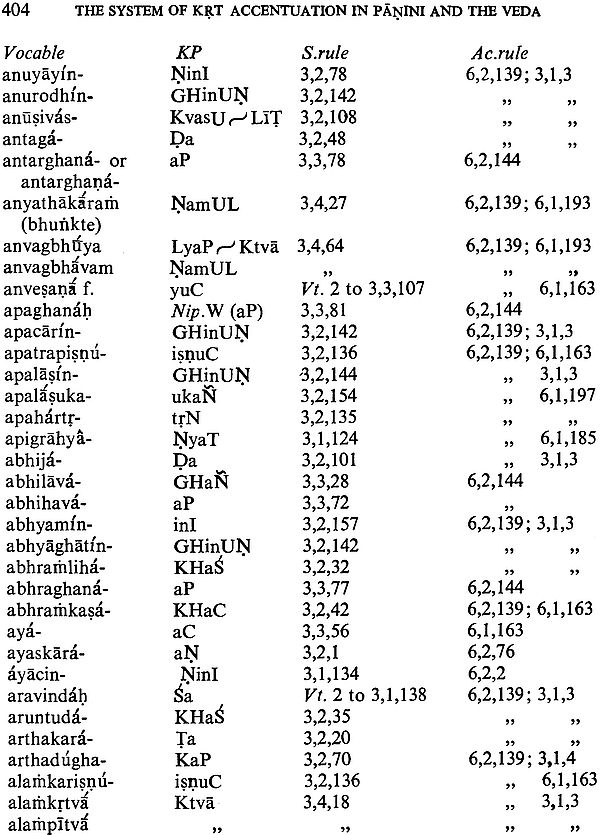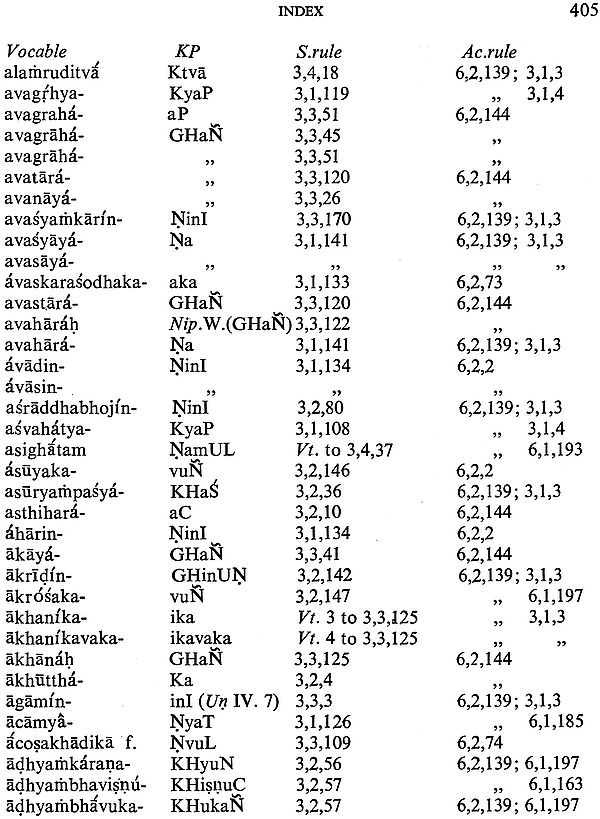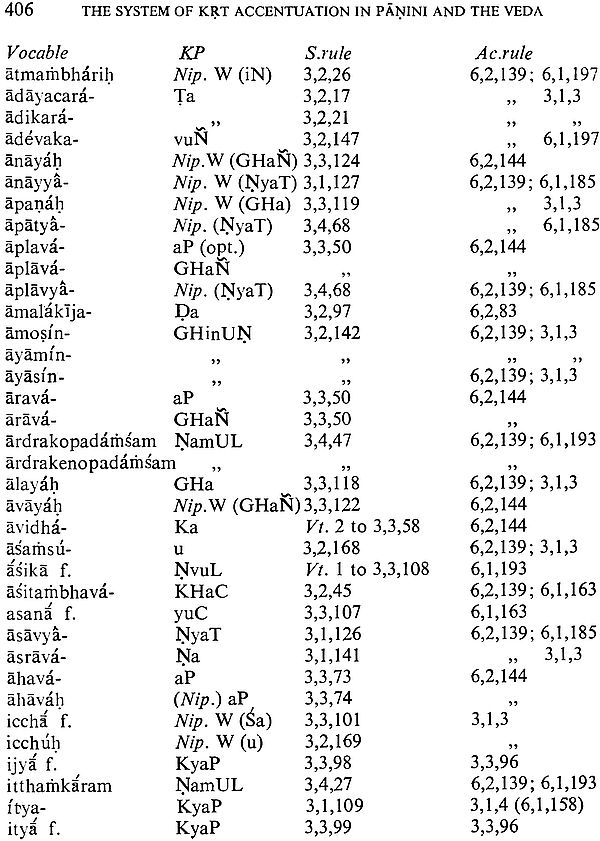
The System of Krt Accentuation in Panini and the Veda (A Old and Rare Book)
Book Specification
| Item Code: | IDK331 |
| Author: | M.D. Balasubrahmanyam, Principal, K.S. Vidyapeetha |
| Publisher: | Kendriya Sanskrit Vidyapeetha, Tirupati |
| Language: | English |
| Edition: | 1981 |
| Pages: | 595 |
| Cover: | Hardcover |
| Other Details | 9.6" X 7.3" |
| Weight | 1.34 kg |
Book Description
Foreword
It gives me great pleasure to introduce to the world of scholars one of a series of critical and comparative studies based on the analysis of Panini's great work on Sanskrit Grammar, the Astadhyayi which has been a source of inspiration not only to India in developing linguistic studies, but also the Western world where modern Linguistics, first as Comparative Philology, has developed and produced such a remarkable field of fruitful and significant activity in the domain of communication.
Ever since the Deccan College, in Poona, one of the oldest educational centres in India, was founded in 1821 and reorganized in 1937-39 as a foundation for postgraduate studies and research in Linguistics, History and Social and Anthropological studies, its contribution to Sanskrit and in particular to Panini and his school have been significant. With its manuscripts collections and the publication of the Bombay Sanskrit Series, and the former glorious traditions associated with such distinguished scholars like BHANDARKAR, KIELHORN and others, the newly reorganized Research Institute undertook to take up the intensive study of Panini and his school, in comparison with other systems of Sanskrit grammar during the first two decades since 1940, which included the comparative study of Dhatupathas, Ganapathas, Linganusasana etc. some of which have been published by the Deccan College itself. It was my privilege as the first Professor of Indo-European Philology and the second Director of this Institute to inaugurate this special trend; the seeds these studies both in Poona and elsewhere, with the establishment of the Centres of Advanced Study in Sanskrit and Linguistics respectively in the University of Poona and the Deccan College and in the Kendriya Sanskrit Vidyapeetha which the Government of India has established in various parts of India. It is indeed a matter of satisfaction to me to see that the staff at the Centres of Advanced Study in Sanskrit and Linguistics is constituted by scholars trained in or forming part of the Deccan College which, during the three decades 1940-70 has been the main source of inspiration for the development of linguistic studies in the country with its Language Project which made possible the establishment of nearly twenty university departments of linguistics all over the sub-continent and for the first time made Linguistics a major subject of study at the university level.
The present work by Dr. M D. Balasubrahmanyam represents his doctoral dissertation submitted to the University of Poona in 1967 and deals with a very important aspect of Panini's grammar, that of accentuation. Panini, alone among Indian grammarians, has made this an essential feature of his grammar. His use of the three accents as integral markers in specifying the nature of the verbal stem regarding voice and other features, and his specification of accents associated with primary and secondary derivation and the metalinguistic use made of the accents is a unique feature, and requires an elaborate examination in relation to Vedic tradition. The question whether accent played an important role as that in the Vedic tradition in the actual speech of Panini's time is a matter which needs careful investigation, since by the time of Katyayana and Patanjali, this feature may have disappeared in the colloquial speech. But comparative Indo-Aryan studies have shown that accent did play a role in the development of early Middle Indo-Aryan, but much more detailed studies are needed in this direction. Dr. Balasubrahmanyam was specially qualified to undertake this study and had the advantage of consultation with a scholar of repute who has edited the Svarasiddhantacandrika. It was from Deccan College that the author of this work went over to the newly created Centre of Advanced Study in Sanskrit at the University of Poona and then to the Mendriya Sanskrit Vidyapeetha at Tirupati. The printing of the work was undertaken in the late sixties, but its publication was delayed by circumstances beyond the control of the author. One must be grateful that at long last the work is now being published and made available to scholars. It is also significant that the date of its publication coincides with the first international conference on Paninian studies which the Centre of Advanced Study in Sanskrit at the University of Poona is inaugurating this summer in Poona.
It is a matter of great satisfaction to me to see that the seeds which were sown in the Deccan College by the publication of KIELHORN'S edition princeps of Patanjali's Mahabhasya and the edition and translation of Paribhasendusekhara of Nagoji Bhatta sustained the development of the Department of Linguistics at the reorganized Research Institute and Became the instrument and feeder in developing and manning the proliferation of departments all over the country and in establishing one of the must significant developments in the field of Sanskrit studies in the great undertaking at the Deccan College of a Dictionary of Sanskrit on Historical Principles. I have great pleasure in commending this book and introducing it to scholars interested in Paninian and Vedic Studies.
Preface
The Present work almost reproduces my thesis on The System of Krt Accentuation in Panini and the Veda, submitted to the University of Poona (now written as Pune) in November, 1967 for the degree of Doctor in Philosophy in the field of Sanskrit Linguistics. Although no substantial changes mark this book, I am glad to have had the opportunity of revising the chapters carefully and adding certain relevant footnotes to the thesis, since some research papers have appeared in the twin fields of Panini and the Veda between 1967-1980. Consequently the Bibliography given at the end of the book has been made uptodate. I have found it appropriate to eliminate completely Section Four of the Third Chapter of the thesis (.4: pp. 666-755) dealing with the accentuation of three individual krt-words, amavasya, arya - and hayana- in order that the bulk of the book may be reduced and its publication be brought out well in time. However, this section (3. 4) is incorporated in my forthcoming volume, Studies in Panini and the Veda. Professors W. P. Lehmann (University of Texas, USA) and K. A. S. Iyer (Lucknow) have been kind enough to go through my work and offer some useful suggestions, besides pointing out several typographic errors that have crept in the thesis. Accordingly I have corrected the errors and carried out their suggestions in the present volume.
The idea that a thesis needed to be written on the System of Accentuation in Panini and the Veda was suggested to me by my revered Guru, Professor Dr. Sumitra Mangesh Katre when he was Director of Deccan College at Pune. He gave us a Summer Course of Lectures on "Indian Linguistics" at Coimbatore in 1959 and on "Lexicography" at Deccan College, Pune, in 1960. it was at the latter school he introducted me to the technique of linguistic research. He directed my research work at Deccan College from 1961 to 1967 with utmost care and loving kindness. I owe an incalculable debt of gratitude to him for his guidance, and I hope I have lived up to the great expectations of the KATREAN SCHOOL OF INDIAN LINGUISTICS. I thank him sincerely for writing the Foreword to this book, which speaks for itself, since it stems from the powerful pen of Dr. Katre who has dedicated all his life to the cause of the neo-linguistic studies apropos of the grammatical triumvirs-Panini, Katyayana and Patanjali initiated by him at Deccan College. The seeds sown by him at Poona have now grown into a beautiful tree, and his pupils now working in the Tirupati Vidyapeetha and elsewhere are trying to silhoutee its stringy shoots and shapely leaves.
The study could not have been made without the unfailing help, the vast teaching experience, the grammatical erudition and the Vedic learning of Sastraratna, Vyakaranarnava, Prof. K. A. Sivaramakrishna Sastri. I learnt the Mahabhasyam of Patanjali on the Four Pada-s of the Third Adhyaya of Panini's Astadhyayi under him in the traditional style. He went through the first two chapters of my thesis, to see whether I have taken any unwarranted liberty with the language of Panini or of Patanjali. I remain grateful to him for his valuable assistance at all stages of my studies.
I owe a deep debt of obligation to Professor Dr. Shivaram D. Joshi (Now Director of the Centre of Advanced Study in Sanskrit (=CASS), University of Pune) for not only helping me in the interpretation of the difficult Vyakarana texts, but also answering my endless queries with never-failing patience and generosity over a long period of years. As an outstanding exponent and critic of the Vyakarana architectonics, he went through my manuscript and offered a number of constructive criticisms. I cannot forget the happy days I spent with him at Pune from 1961 to 1968.
When I was a Senior Research Scholar of Cass during the years 1965-68, Professor R. N. Dandekar eviniced encouraging interest in the progress of my studies. I offer my sincere thanks to him for the fine working conditions he provided for us at Cass.
I thank Professors A. M. Ghatage and N.G. Kalelkar for permitting me to attend their lectures on Historical Linguistics and French respectively, delivered at Deccan College during the years 1963-65.
My colleague, Dr. N. S. Ramanuja Tatacharya (Professor, Kendriya Sanskrit Vidyapeetha, Tirupati) made useful suggestions on one or another portion of the book. Dr. J. A. F. Roodbergen (University of Amsterdam) assisted me in reading some difficult papers and books written in German and French. Shri V. B. Belsare, Librarian at Deccan College, gave me valuable assistance in securing several microfilmed copies of rare and out-of print books and research papers from foreign libraries. Dr. Hukam Chand Patyal (Deccan College) helped me in the compilation of the Index Verborum and meticulously verified references made in the text and the Bibliography. Dr. P. Meegaskumbura (University of Ceylon, Peradeniya) corrected several typing errors found in the thesis. T.N.Balaram, Technical Laboratory Assistant, K. S. Vidyapeetha, Tirupati put some of the revised papers through the typewriter.
To all these friends I beg to express my sincere gratitude.
I acknowledge the generosity shown by the Board of Directors of Jaffna College Vaddukoddai, Cylon (especially Rt. Rev. S. Kulandran, Rev. Dr. S.K. Bunker and Mr. E. C. Lockwood) and the University Grants Commission in providing the necessary financial assistance for carrying out my research project from 1961 to 1967.
It is now my pleasant obligation to thank the members of the Research and Publication Committee of the erstwhile Kendriya Sanskrit Vidyapeetha Tirupati Society which consisted of M. Ananthasayanam AYYANGAR (Chairman), Drs. B. R. Sharma (the First Director of Kendriya Sanskrit Vidyapeetha), R. K. Sharma (now Director of Rashtriya Sanskrit Sansthan), S. M. Katre, Aryendra Sarma, P. L. Vaidya, and V. Raghavan for having approved the publication of my thesis in 1969. Accordingly the printing of the book was undertaken-thanks to the encouraging interest shown in its publication by Dr. B. R. Sharma-by Kendriya Sanskrit Vidyapeetha, Tirupati; and now it appears under Series No. 32.
I am obliged by the regulations of the University of Poona to state here that the authorities of the said University granted me permission to publish the thesis for which the degree of Ph. D. was conferred on me in 1968.
My wife (M. B. Brhadamba) and children (Kumari M. B. Suparna and Master M. B. Sukhasvami) were kind enough to allow me to be away from home for several years, which enabled me to devote my concentrated attention on my studies.
Finally, special acknowledgement should be made to the Director, Mangalore Trading Association Private Ltd., and their Sharada Press, Mangalore for setting the appropriate types for this volume with rigour and patience. The staff of the press completed an exceedingly difficult task of printing the book which abounds in symbols and diacritics. If, inspite of all the care taken to bring the text to perfection, errors are found in it, I bear the responsibility for these occasional lapses. And I am well aware of the truth: To err is human, and to forgive is divine.
| Foreward | ix | |
| Preface | xiii | |
| Editions of original Texts, Dictionaries, | xxvii | |
| | ||
| 0. | Introduction | ii |
| 0.0 | The Traditional Approach | ii |
| 0.01 | Vedic hermeneutists | iii |
| 0.02 | Panini | iv |
| 0.03 | Katyayana | x |
| 0.04 | Patanjali | xv |
| 0.05 | The Paninian Commentators | xxi |
| 0.06 | The Svara-Manuals | xxiv |
| 0.10 | The Western Approach | xxvi |
| 0.11 | Comparative accentuation of IE languages | xxvi |
| 0.12 | Studies on Vedic Accentuation | xxviii |
| 0.13 | Nature of Vedic accent and Vedic Recitation | xxix |
| 0.14 | Panini and Vedic language | xxx |
| 0.2 | The Indian Approach | xxxiii |
| 0.21 | The nature of Vedic accent and vocal tradition | xxxiv |
| 0.22 | Studies on accentuation | xxxv |
| 0.3 | The Thesis-Scope, Corpus and Methodology | xxxviii |
| 0.30 | Scope of the thesis | xxxviii |
| 0.31 | Corpus | xxxviii |
| 0.32 | Methodology | xli |
| 0.33 | Sings and Abbreviations | xliii |
| | ||
| 1 | Word-Accent and P.'s Accentual Principles | 1-23 |
| 1.0 | Word-accent | 1 |
| 1.1 | IE tendency | 1 |
| 1.2 | Greek word-accent | 1 |
| 1.3 | Vedic word-accent | 2 |
| 1.4 | Comparative evidence | 3 |
| 1.5 | Pratisakhya Theory-VPr. Ii. 1;2 | 7 |
| 1.6.0 | P.'s testimony-A 6, 1,158 | 11 |
| 1.6.1 | Pat. On A 6, 1,158 Introduction | 12 |
| 1.6.2 | The meaning of the rule 158 | 12 |
| 1.6.3 | The purpose of the rule 158 | 13 |
| 1.6.4 | Kat.'s propositions | 15 |
| 1.6.5 | 158-a Paribhasa rule | 17 |
| 1.7 | The general maxim relating to the operation of accentual rules. | 17 |
| 2. | The Paninian Position | 27-246 |
| 2.0 | Anubandhas in P's system | 27 |
| 2.0.0 | The Anubandha system | 27 |
| 2.0.1 | Anubandha derivation and meaning | 28 |
| 2.0.2 | Panini's ITs | 29 |
| 2.0.3 | IT-one of the models of grammatical description in P. | 32 |
| 2.1 | Accent Anubandhas | 36 |
| 2.1.0 | Accent Its in Krt suffixes | 36 |
| 2.1.1 | Position of occurrence of accent ITs | 37 |
| 2.1.2 | Distribution of accent Its in 75 suffixes | 38 |
| 2.1.3 | Symbols indicating the three pitch accents | 39 |
| 2.1.4 | Niyata-svara-pratyayas versus aniyata-svara-pratyayas: Pat's evidence | 40 |
| 2.1.5 | The Its C, N, and N-their special purpose | 42 |
| 2.1.5.0 | C/N/N | 42 |
| 1 | C in trC | 43 |
| 2 | C in yuC | 45 |
| 3 | C in KtiC | 47 |
| 4 | C in KhaC | 48 |
| 5 | C in KhisnuC | 48 |
| 6 | C in NaC | 50 |
| 7 | C in vIC | 51 |
| 8 | N in KaN | 52 |
| 9 | N in GhaN | 53 |
| 10 | N in NyuT | 53 |
| 11 | N in KvIN | 53 |
| 2.1.5.12 | N in NvIN | 55 |
| 2.2 | Non-Accent Its | 55 |
| 2.2.0 | 13 non-accent Its | 55 |
| 2.2.1 | Position of occurrence of non-accent ITs | 56 |
| 2.2.2 | Distribution of non-accent Its in krt suffixes | 56 |
| 2.2.3 | Select functions of non-accent ITs | 60 |
| 2.3 | The Krt-Pratyayas: Formal Analysis | 62 |
| 2.3.0 | The structure of krt-pratyayas | 62 |
| 2.3.1 | 56 bound morphemes | 64 |
| 2.3.2 | The alphabetical arrangement of 128 KPs | 65 |
| 2.3.2.0 | Table 8 | 65 |
| 2.3.2.1 | Notes to Table 8 | 67 |
| 2.3.3 | The alphabetical rearrangement of KPs | 67 |
| 2.3.3.0 | Table 9 | 67 |
| 2.3.3.1 | Accentual Notes to Table 9 | 67 |
| 2.3.4 | Distribution of 56 bound morphemes in 128 KPs | 73 |
| 2.3.4.0 | Table 10 | 73 |
| 2.3.4.1 | Notes to Table 10 | 75 |
| 2.3.5 | The accentual pattern of bound morphemes | 82 |
| 2.3.5.0 | Table 11-A | 82 |
| 2.3.5.1 | Notes to Table 11-A | 82 |
| 2.3.5.2 | The rearrangement of accentual pattern-Table 11-B | 91 |
| 2.3.5.3 | Notes to Table 11-B | 98 |
| 2.4 | KPs: Functional Analysis | 112 |
| 2.4.0 | Select Functions of KPs-Table 12 | 112 |
| 2.4.1 | Notes of Table 12 | 128 |
| 2.5 | Structure of Krt Derivatives | 135 |
| 2.5.0 | The components of a KD | 135 |
| 2.5.1 | Formulas for D/CD/W | 136 |
| 2.5.2 | Totos | 137 |
| 2.5.2.0 | A 3, 1,91 | 137 |
| 2.5.2.1 | Distribution of Rs. | 138 |
| 2.5.2.2 | Toot-accent | 139 |
| 2.5.2.3 | KDs derived from the root kr- | 140 |
| 2.5.3 | Upapada Compunds | 151 |
| 2.5.3.0 | Structure of upapada | 151 |
| 2.5.3.1 | Table showing U-rules in Book III | 152 |
| 2.5.3.2 | Accentuation of U-cpd.s | 153 |
| 2.5.3.3 | Upapada categories | 159 |
| 2.6 | Accentuation of KDS | 164 |
| 2.6.0 | Accentual categories | 164 |
| 2.6. 1 | 167 | |
| 2.6.2 | -a | 168 |
| 2.6.3 | -aka | 173 |
| 2.6.4 | -at- | 174 |
| 2.6.5 | -athu- | 175 |
| 2.6.6 | -ana- | 175 |
| 2.6.7 | -ani- | 176 |
| 2.6.8 | -aniya- | 177 |
| 2.6.9 | -am | 177 |
| 2.6.10 | -aka- | 177 |
| 2.6.11 | -ana- | 177 |
| 2.6.12 | -aru- | 178 |
| 2.6.13 | -alu- | 178 |
| 2.6.14 | -i- | 179 |
| 2.6.15 | -itra- | 179 |
| 2.6.16 | -in- | 180 |
| 2.6.17 | -isnu- | 181 |
| 2.6.18 | -i- | 182 |
| 2.6.19 | -uka- | 182 |
| 2.6.20 | -ura- | 183 |
| 2.6.21 | -uka- | 183 |
| 2.6.22 | -ta- | 184 |
| 2.6.23 | -tavat- | 185 |
| 2.6.24 | -tavya- | 186 |
| 2.6.25 | -ti- | 187 |
| 2.6.26 | -tum | 188 |
| 2.6.27 | -tr- | 189 |
| 2.6.28 | -tra- | 190 |
| 2.6.29 | -tri- + - ma- | 191 |
| 2.6.30 | -tva | 191 |
| 2.6.31 | -thaka | 192 |
| 2.6.32 | -na- | 192 |
| 2.6.33 | -naj- | 193 |
| 2.6.34 | -nu- | 193 |
| 2.6.35 | -man- | 193 |
| 2.6.36 | -mara- | 194 |
| 2.6.37 | -ya- | 194 |
| 2.6.38 | -ra- | 196 |
| 2.6.39 | -ru- | 197 |
| 2.6.40 | -luka- | 197 |
| 2.6.41 | -van- | 198 |
| 2.6.42 | -vara- | 199 |
| 2.6.43 | -vas- | 200 |
| 2.6.44 | -snu- | 201 |
| 2.7 | Accentual Rules in A.6,1 | 202 |
| 2.7.0 | 28 Accentual rules | 202 |
| 2.7.1 | General accentual rules | 203 |
| 2.7.2 | Rules for accent ITs | 203 |
| 2.7.3 | Special accentual rules | 203 |
| 2.7.3.0 | Accentual types | 203 |
| 1. A 6,1,159 | 204 | |
| 2. 194 | 206 | |
| 3. 200 | 207 | |
| 4. 205 | 207 | |
| 5. 214 | 207 | |
| 6. 173 | 209 | |
| 7. 174 | 210 | |
| 8. 186 | 210 | |
| 9. 189 | 211 | |
| 2.7.4 | Accentual rules for words | 212 |
| 2.7.4.0 | Accentual classes | 212 |
| 1. A 6, 1, 160 | 212 | |
| 2. 203 | 215 | |
| 2.7.4.3 | Accentuation of individual words | 219 |
| 4. A 6, 1,201 | 219 | |
| 5. 202 | 220 | |
| 6. 206 | 220 | |
| 7. 207 | 221 | |
| 8. 208 | 222 | |
| 9. 215 | 222 | |
| 2.7.4.10 | 6, 1, 216 | 225 |
| 2.8 | Accentuation of CDS in A 6,2 | 227 |
| 2.8.0 | Accentual types | 227 |
| 2.8.1.0 | Type I | 227 |
| 1 | Table 34 showing accentual classes of Type i | 228 |
| 2 | Illustrative material for Type i | 229 |
| 3 | CDs in | 231 |
| 4 | CDs in a- | 232 |
| 5 | DCs in aka- | 234 |
| 6 | CDs in ana- | 235 |
| 7 | CDs in itra- | 235 |
| 8 | CD in in- | 235 |
| 9 | CDs in ta- | 239 |
| 10 | CDs in -tave | 240 |
| 11 | CDs in -tavai | 240 |
| 12 | CDs in ti- | 240 |
| 13 | CDs in tr- | 240 |
| 14 | CDs in -tum | 240 |
| 15 | CDs in tos- | 241 |
| 2.8.2 | Type II | 241 |
| 2.8.2.0 | na N-accentuation | 241 |
| 1 | Table showing accentual classes of Type ii | 241 |
| 2 | Illustrative material for Type ii | 242 |
| 3 | naN cpd.s in ani- | 243 |
| 4 | naN cpd.s in Kata (A 6,2,116) | 243 |
| 5 | naN cpd.s in aC, Ka | 244 |
| 6 | naN cpd.s in Kta (A 6,2,159) | 244 |
| 7 | naN cpd.s in Krtya-s, -uka-, isnuC | 244 |
| 8 | naN cpd.s in trN | 246 |
| 3. | The Veda in Panini | 249-397 |
| 3.0 | Panini and the Vedic facts: Prolegomena | 249 |
| 3.0.0 | P.'s Vedic rules | 249 |
| 1 | Number of Vedic rules in the A | 249 |
| 2 | P.'s general rules: their applicability to Chandas | 252 |
| 3 | Three divisions of Chandas | 252 |
| 4 | The domain of Chandas | 252 |
| 5 | P.'s method of teaching Chandasi-rules | 253 |
| 3.0.6 | P.'s knowledge of the Veda | 254 |
| 7 | The term 'Bhasayam' | 266 |
| 3.1 | Vedic data in Book III, Padas 1-3 | 267 |
| 3.1.0 | Vedic rules in III. 1-3 | 267 |
| 1 | 269 | |
| 2 | -ana- | 279 |
| 3 | -ana- | 283 |
| 4 | -i- | 284 |
| 5 | -isnu- | 288 |
| 6 | -u- | 289 |
| 7 | -ta- | 290 |
| 8 | -ti- | 292 |
| 9 | -man- | 299 |
| 10 | -ya- | 300 |
| 11 | -van- | 311 |
| 12 | -vas- | 312 |
| 3.2 | Vedic Data In Book III, Pada 4 | 313 |
| 3.2.0 | Infinitive BMs: Introduction | 313 |
| 3.2.0.2 | Vedic Infinitives: the Western approach | 314 |
| 3.2.1 | -adhyai | 318 |
| 2. | -am | 325 |
| 3. | -as- | 327 |
| 4. | -ase | 330 |
| 5. | -isyai | 335 |
| 6. | -e | 336 |
| 7. | -enya- | 339 |
| 8. | -ai | 341 |
| 9. | -tave | 341 |
| 10. | - tavai | 347 |
| 11. | -tos- | 354 |
| 12. | -tva- | 358 |
| 13. | -se | 360 |
| 3.3 | P's General Rules And Vedic Accentuation | 365 |
| 3.3.0 | Krt Ds formed with 39 KPs in P. and the Veda | 365 |
| 1 | 365 | |
| 2 | -a- | 366 |
| 3 | -at- | 371 |
| 4 | -athu- | 371 |
| 5 | -ana- | 371 |
| 6 | -aniya- | 372 |
| 7 | -am | 372 |
| 8 | -ana- | 373 |
| 9 | -aru- | 373 |
| 10 | -alu- | 374 |
| 11 | -i- | 374 |
| 12 | -itra- | 374 |
| 13 | -in- | 375 |
| 14 | -isnu- | 376 |
| 15 | -u- | 376 |
| 16 | -uka- | 376 |
| 17 | -ura- | 377 |
| 18 | -uka- | 377 |
| 19 | -ta- | 377 |
| 20 | -tavua- | 379 |
| 21 | -ti- | 379 |
| 22 | -tum | 380 |
| 23 | -tr- | 380 |
| 24 | -tra- | 381 |
| 25 | -tri + ma- | 381 |
| 26 | -tva | 382 |
| 27 | -na- | 382 |
| 28 | -naj- | 383 |
| 29 | -nu- | 383 |
| 30 | -ma- | 383 |
| 31 | -man- | 383 |
| 32 | -mara- | 383 |
| 33 | -ya- | 383 |
| 34 | -ra- | 386 |
| 35 | -ru- | 387 |
| 36 | -van- | 387 |
| 37 | -vara- | 388 |
| 38 | -vas- | 388 |
| 39 | -snu- | 388 |
| 3.4 | Vyatyayo Bahulam | 388 |
| 3.4.0 | Convergence versus Divergence | 388 |
| 3.4.1 | A 3, 1, 85 | 389 |
| 3.4.2 | Svara-vyatyaya-s | 391 |
| Conclusion | 398-402 | |
| Index Verborum | 403-488 | |
| Part I Secular (non-Vedic) Vocables | 403-432 | |
| Part IIA: Vedic Vocables | 433-437 | |
| Part IIB: Vedic Infinitives | 238-444 | |
| Part III: Vocables common to Chandas and Bhasa | 445-488 | |
| Bibliography | 489-488 | |
| Errata | 511 |
